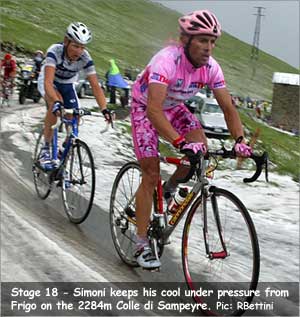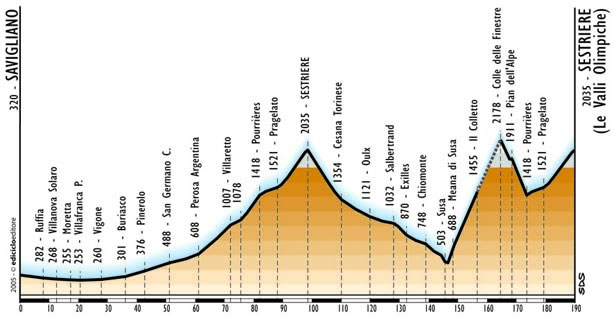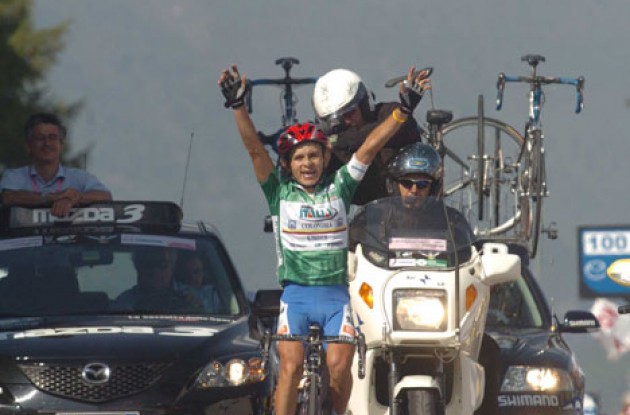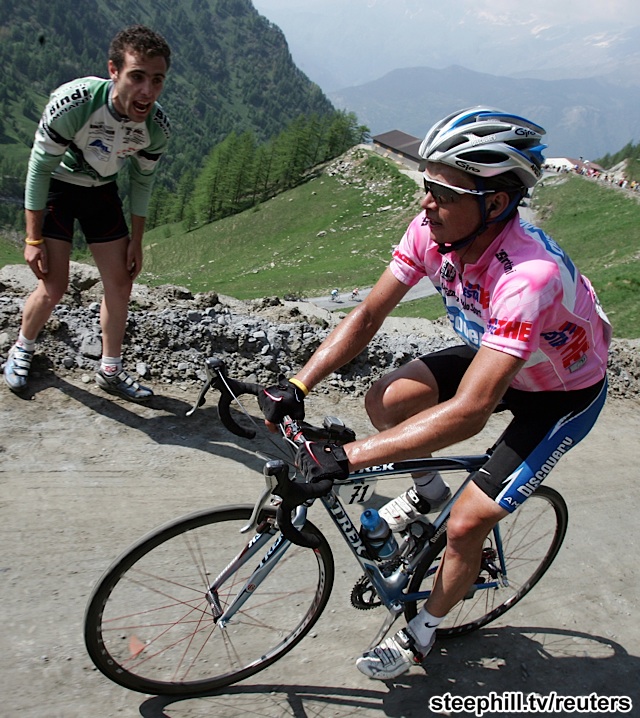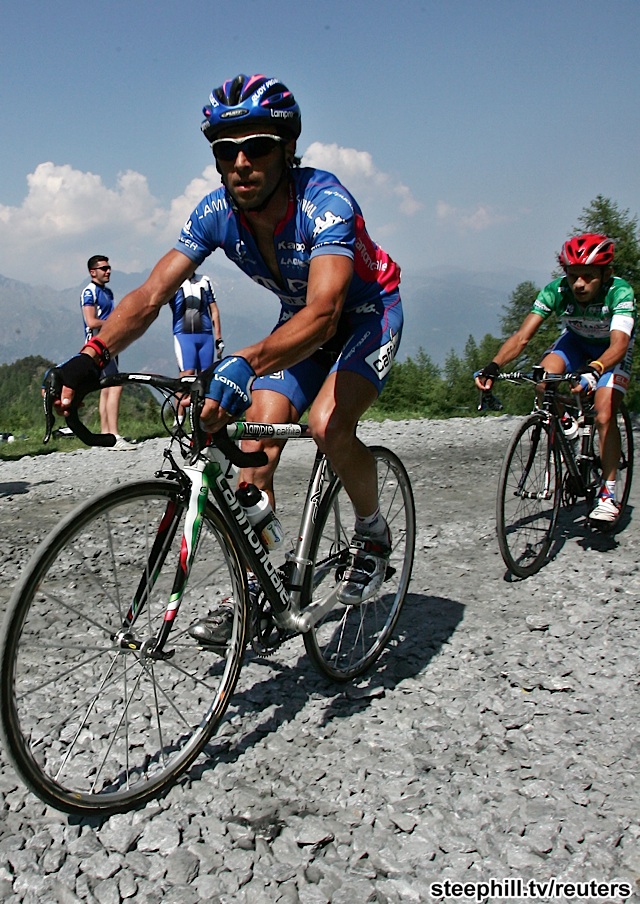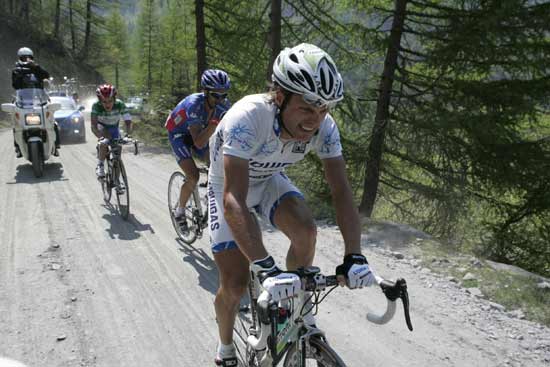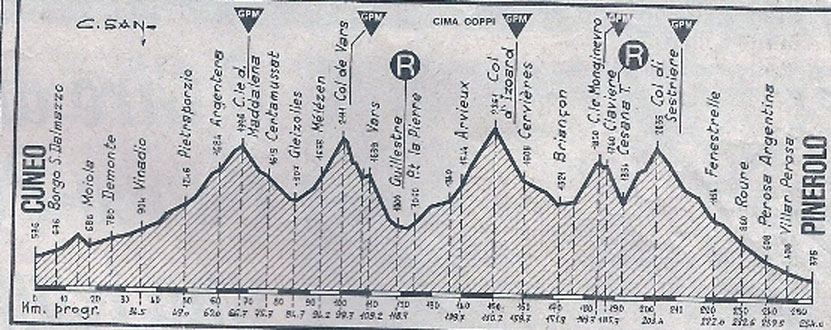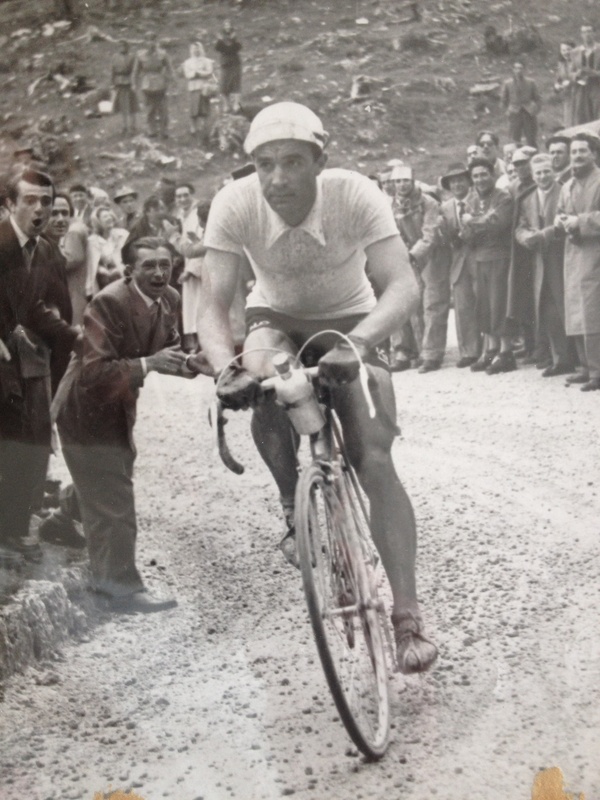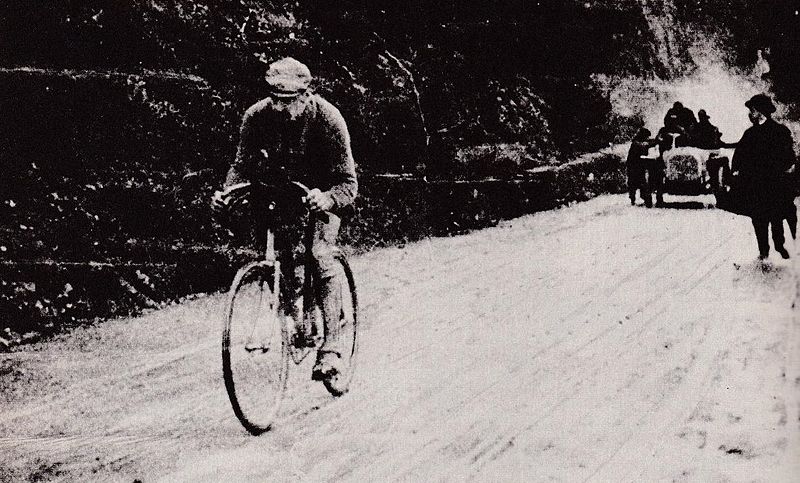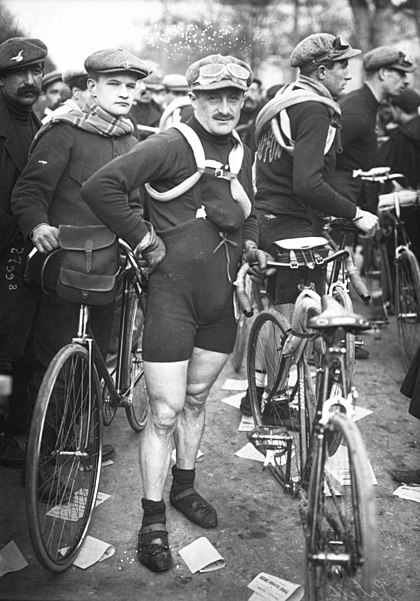- Mar 24, 2011
- 10,527
- 1,927
- 25,680
100th Giro stage 16: Chiesa in Valmalenco - Bormio 120 km
Stage type: High Mountain
Difficulty: ****
Original stage: Giro 1988 stage 14
Climbs: Aprica (GPM.2), Passo di Gavia (GPM.1)

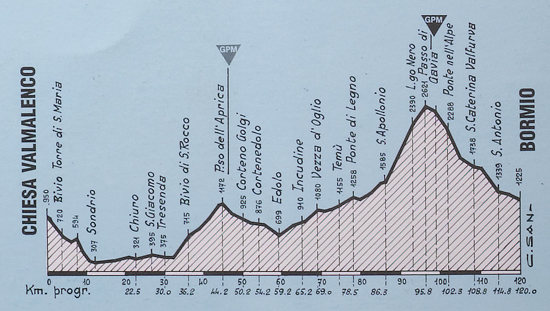
Overview:
The mountain triplet ends with the easiest stage of the lot. Still, a Gavia descent finish isn't a piece of cake.
Giro of the stage:
The 1988 Giro started in Urbino, and ended in Vittorio Veneto after 21 stages (2 of which divided in 2 sectors, and with no rest days), following a clockwise loop. After the prologue in Urbino, the main features were a 40 km TTT to Vieste, the hilly/mountain stages to Campitello Matese, Selvino, Chiesa in Valmalenco, Bormio, Merano 2000, Innsbruck and Borgo Valsugana, before a MTT to the Valico del Vetriolo and a rather underwhelming finale, with a couple of flat stages before the final ITT in Vittorio Veneto.
With the defending champion Stephen Roche not competing due to an injury, the race was considered very open, with lots of possible candidates: Roberto Visentini and Franco Chioccioli were the only two Italian hopes, while the list of strangers was far more impressive: Erik Breukink, Andrew Hampsten, Urs Zimmermann, Pedro Delgado, Jean-François Bernard, Tony Rominger... even Greg Lemond was there, although just coming back from an injury and allegedly not in full shape. As for the stage hunters, Johan Van Der Velde and Moreno Argentin were there, as always.
Bernard won the prologue and wore pink until stage 4, were Massimo Podenzana took it thanks to a breakaway. He kept it for quite a long time, even surviving the first MTF to Campitello Matese, won by Chioccioli. He lost it on the stage to Selvino, won by Hampsten, when Chioccioli himself got the jersey. The following stage, to Chiesa in Valmalenco, was won by Rominger, with Chioccioli keeping the jersey.
Stage of the stage:
Nowadays the Gavia is considered a classic climb, but actually it was previously used only once in the Giro, in 1960. It was a terrible climb for the time standards, not just because of the length, gradient and altitude, but especially because of the fact that it was partially unsurfaced. This was considered a key stage at the start of the Giro, and GC riders were looking forward to it. On the night before the stage it snowed on the Gavia, but the road had been cleared in the morning and after extensive discussions between organizers and team directors it was decided to proceed with the stage as planned.
On the climb to Aprica there is already a good selection in the peloton, but everything comes together pretty quickly, as the weather starts to get worse. It rains now, and the wind is already very cold. Most of the riders wear standard jerseys, a totally insufficient gear for that day. The peloton however reaches Ponte di Legno without big problems and starts climbing the Gavia. Almost immediately Van Der Velde attacks and breaks away alone. The tarmac ends, and the mud replace it. Soon the rain becomes snow, and the snow becomes a full blizzard. At the top there are -5 °C, the wind blows terribly and visibility is almost nil. There are today many reports of this famous stage, but not many of them have any clue of what happened to the race itself from the final 5 kms to the Gavia on. Of course there's no TV signal, the spectators, mechanics and team directors soon become too busy helping the riders to care about the race situation at all. Van Der Velde reaches the top first, that much is known, but he is already risking hypothermia, and the worst is yet to come: the descent. Soon he has to stop and step inside the camper of a spectator to get warm and disappears from the race. Behind him, Hampsten gets the lead. On the descent the spectators he meets are not even sure the race is still on. They are walking in the middle of the road as if they're lost. Hampsten even finds a mechanic lost in the blizzard, wandering with two wheels on his shoulder, swearing at his team director who left him there, apparently. Most of the riders abandon, or step into cars to get warm and continue their descent again. Some of them stop descending a climb a little on the opposite way to feel warm. Hampsten only has one gear available, as his gearbox is frozen, and its a very short gear, so he can keep pedalling during all the descent. The pink jersey, Chioccioli, is totally left on his own, since his admiral is assisting his teammates behind him. At 6 kms to go, somebody unexpectedly overtakes Hampsten: it is Breukink, who goes on and wins the stage, with only 7" over Hampsten. Both of them are in horrible conditions. Hampsten will realize to have won the pink jersey only later, after being in the warm team car for some time. Behind the first two there's the void. the third coming is the Italian Stefano Tomasini, at 4'40". Zimmermann and Chioccioli arrive 6th and 7th, at over 5', with the pink jersey almost unconscious. The attenders have trouble to even get him off the bike, his hands frozen firmly to the handlers. Delgado arrives at 7', Bernard at over 9', Visentini and Rominger at around 30'. Van Der Velde reappears at over 45', he will win the points classification of the Giro, and it will be his last major accomplishment.
Hampsten will defend his jersey from Breukink in the following days, and even win the MTT to Vetriolo. He will become the first non-European winner in the Giro history. Breukink and Zimmermann will complete the podium.
Protagonists of the stage:
Erik Breukink:

Andrew Hampsten:

Johan Van der Velde:
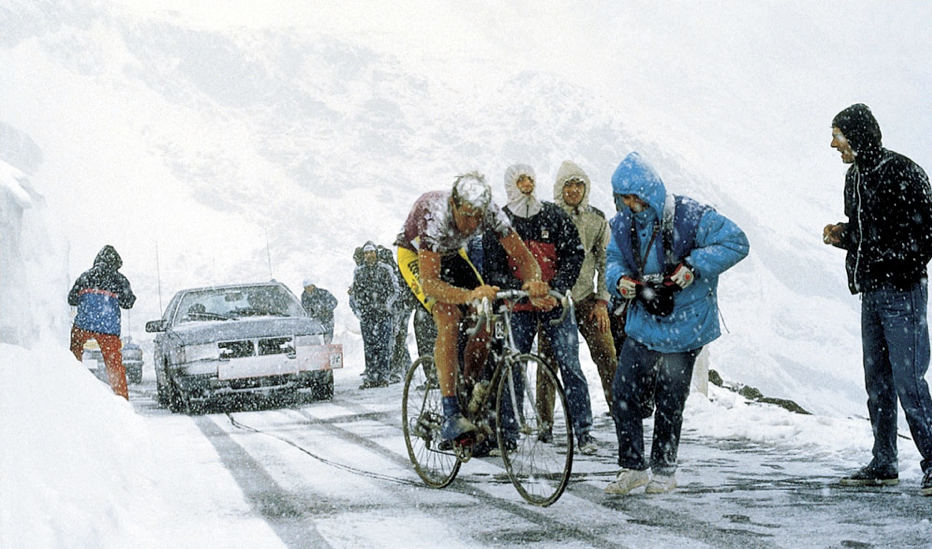
Franco Chioccioli:
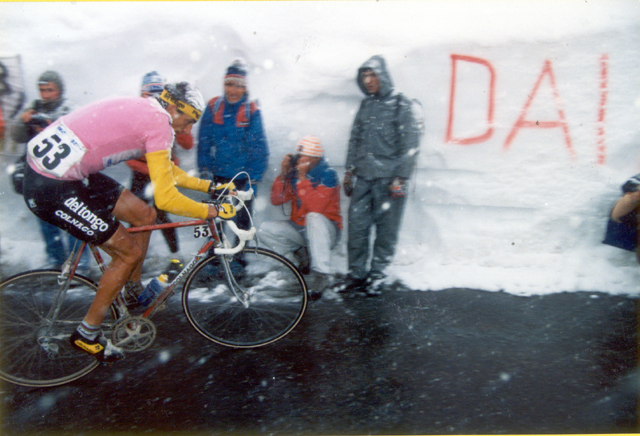
Next stage:
The greatest show on earth will move to the west coast!
...this is too easy...
Stage type: High Mountain
Difficulty: ****
Original stage: Giro 1988 stage 14
Climbs: Aprica (GPM.2), Passo di Gavia (GPM.1)


Overview:
The mountain triplet ends with the easiest stage of the lot. Still, a Gavia descent finish isn't a piece of cake.
Giro of the stage:
The 1988 Giro started in Urbino, and ended in Vittorio Veneto after 21 stages (2 of which divided in 2 sectors, and with no rest days), following a clockwise loop. After the prologue in Urbino, the main features were a 40 km TTT to Vieste, the hilly/mountain stages to Campitello Matese, Selvino, Chiesa in Valmalenco, Bormio, Merano 2000, Innsbruck and Borgo Valsugana, before a MTT to the Valico del Vetriolo and a rather underwhelming finale, with a couple of flat stages before the final ITT in Vittorio Veneto.
With the defending champion Stephen Roche not competing due to an injury, the race was considered very open, with lots of possible candidates: Roberto Visentini and Franco Chioccioli were the only two Italian hopes, while the list of strangers was far more impressive: Erik Breukink, Andrew Hampsten, Urs Zimmermann, Pedro Delgado, Jean-François Bernard, Tony Rominger... even Greg Lemond was there, although just coming back from an injury and allegedly not in full shape. As for the stage hunters, Johan Van Der Velde and Moreno Argentin were there, as always.
Bernard won the prologue and wore pink until stage 4, were Massimo Podenzana took it thanks to a breakaway. He kept it for quite a long time, even surviving the first MTF to Campitello Matese, won by Chioccioli. He lost it on the stage to Selvino, won by Hampsten, when Chioccioli himself got the jersey. The following stage, to Chiesa in Valmalenco, was won by Rominger, with Chioccioli keeping the jersey.
Stage of the stage:
Nowadays the Gavia is considered a classic climb, but actually it was previously used only once in the Giro, in 1960. It was a terrible climb for the time standards, not just because of the length, gradient and altitude, but especially because of the fact that it was partially unsurfaced. This was considered a key stage at the start of the Giro, and GC riders were looking forward to it. On the night before the stage it snowed on the Gavia, but the road had been cleared in the morning and after extensive discussions between organizers and team directors it was decided to proceed with the stage as planned.
On the climb to Aprica there is already a good selection in the peloton, but everything comes together pretty quickly, as the weather starts to get worse. It rains now, and the wind is already very cold. Most of the riders wear standard jerseys, a totally insufficient gear for that day. The peloton however reaches Ponte di Legno without big problems and starts climbing the Gavia. Almost immediately Van Der Velde attacks and breaks away alone. The tarmac ends, and the mud replace it. Soon the rain becomes snow, and the snow becomes a full blizzard. At the top there are -5 °C, the wind blows terribly and visibility is almost nil. There are today many reports of this famous stage, but not many of them have any clue of what happened to the race itself from the final 5 kms to the Gavia on. Of course there's no TV signal, the spectators, mechanics and team directors soon become too busy helping the riders to care about the race situation at all. Van Der Velde reaches the top first, that much is known, but he is already risking hypothermia, and the worst is yet to come: the descent. Soon he has to stop and step inside the camper of a spectator to get warm and disappears from the race. Behind him, Hampsten gets the lead. On the descent the spectators he meets are not even sure the race is still on. They are walking in the middle of the road as if they're lost. Hampsten even finds a mechanic lost in the blizzard, wandering with two wheels on his shoulder, swearing at his team director who left him there, apparently. Most of the riders abandon, or step into cars to get warm and continue their descent again. Some of them stop descending a climb a little on the opposite way to feel warm. Hampsten only has one gear available, as his gearbox is frozen, and its a very short gear, so he can keep pedalling during all the descent. The pink jersey, Chioccioli, is totally left on his own, since his admiral is assisting his teammates behind him. At 6 kms to go, somebody unexpectedly overtakes Hampsten: it is Breukink, who goes on and wins the stage, with only 7" over Hampsten. Both of them are in horrible conditions. Hampsten will realize to have won the pink jersey only later, after being in the warm team car for some time. Behind the first two there's the void. the third coming is the Italian Stefano Tomasini, at 4'40". Zimmermann and Chioccioli arrive 6th and 7th, at over 5', with the pink jersey almost unconscious. The attenders have trouble to even get him off the bike, his hands frozen firmly to the handlers. Delgado arrives at 7', Bernard at over 9', Visentini and Rominger at around 30'. Van Der Velde reappears at over 45', he will win the points classification of the Giro, and it will be his last major accomplishment.
Hampsten will defend his jersey from Breukink in the following days, and even win the MTT to Vetriolo. He will become the first non-European winner in the Giro history. Breukink and Zimmermann will complete the podium.
Protagonists of the stage:
Erik Breukink:

Andrew Hampsten:

Johan Van der Velde:

Franco Chioccioli:

Next stage:
The greatest show on earth will move to the west coast!
...this is too easy...








